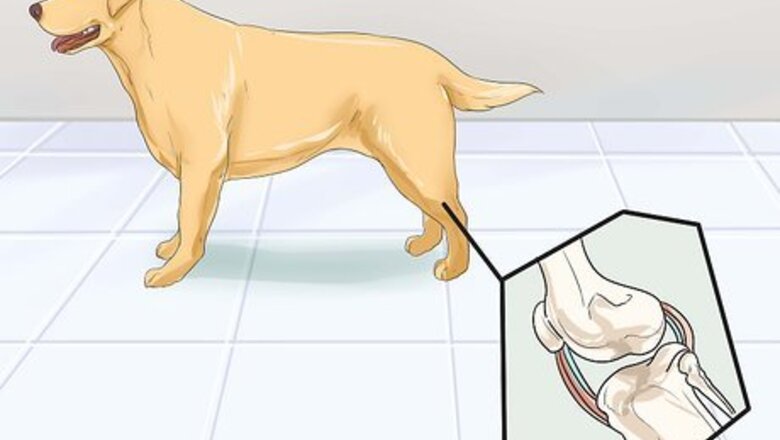
views
X
Research source
Gough, Alex and Alison Thomas, Breed Predispositions to Disease in Dogs and Cats. Wiley-Blackwell, 2010.
If your dog has joint problems and stiffness, you can follow a few simple steps to help them feel better.
Understanding Joint Issues

Learn about your dog's joints. A joint is a connection between two or more pieces of bone. Joints are a wonder because they allow for a wide range of movements in a feat of natural engineering. A joint is formed when two or more bones meet in a movable joint. The important structures to worry about are the bone, the cartilage which lines the joint, the ligaments which hold the bones together, and the tendons with attached muscle which pull on the bone and causes them to move. Lubrication is provided by a viscous substance known as synovial fluid, which also supplies nutrients to the cartilage layer. This fluid is produced by the synovial membrane lining the joint capsule and the ligaments. Both of these are important structures which basically hold the joint or bones together.
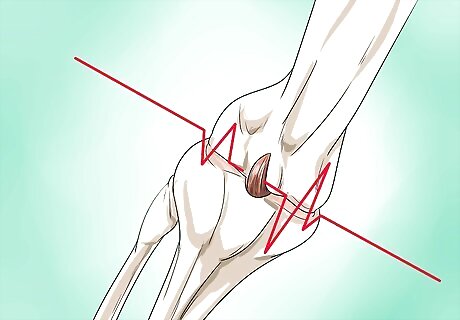
Understand the joint problems. A joint problem can develop when any one of the pieces in the joint is damaged. For example, when the cartilage lining becomes chipped, a ligament snaps, or a muscle sprained, you dog will suffer from a joint injury. There are certain breeds that are predisposed to joint problems. Labradors, golden retrievers, and German shepherds have a genetic tendency to hip and elbow dysplasia, which can lead to early arthritis. Giant breeds such as Leonbergers, St. Bernards, and Great Danes can grow too quickly and damage their soft bones in the process, leading to joint disease.

Recognize the signs. The cardinal sign your dog has a joint problem is pain, which often shows itself as limping. If your dog suddenly starts limping, try to minimize his activity. He may also show other signs, such as awkward movements, difficulty standing, swollen joints, refusal to jump, an aversion to petting, and a bad temper. If he has pain enough to limp or have any other symptom, further running, chasing, or walking is only going to cause more inflammation, more pain, and make the problem worse. You should also not continue to play fetch or any other game with your dog.
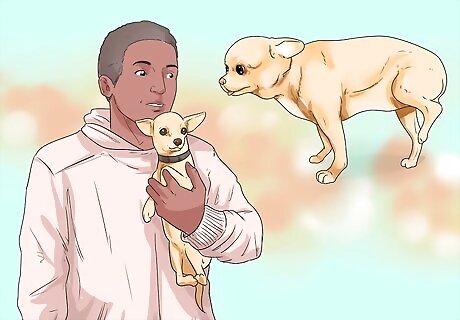
Respond to lameness. If your dog becomes suddenly lame, bring him home and keep him rested. If the dog shows lameness during a walk, depending on the severity of the lameness, carry him home. Do not give medications from your medicine cabinet. If he needs pain relief, contact your veterinarian. If you know which joint he has injured, try putting an ice pack on it for 10 minutes. If he is too big to pick up, put him on the lead and encourage him to walk slowly. If he remains lame, especially if there is no improvement after 24 hours, seek veterinary attention. Keep him rested until he's been checked out.

Notice general stiffness. There are some apparent symptoms of stiffness of the muscles and joints, which is a common problem, especially in elderly pets. Pet owners often see their pet feels stiff or struggle with joint aches when they walk with a stiff gait or limp, become less active, or struggle to get up. Other symptoms are very difficult stretching, reluctance to exercise and stopping on walks, and difficulty in climbing stairs. Some animals will also lick painful joints, making the skin infected and sore. Cold mornings after long periods of rest are often the most difficult for pets with joint or muscle problems. It can take some time for your pet to get going during these mornings.
Treating Joint Issues

Walk your dog. For acute (sudden) injuries, rest is essential. However, for older dogs that are stiff with arthritis it is helpful to keep them moving. If they do not exercise there is a chance their joints will seize up. However, it is critical to find the right level of exercise for your pet. This is done on a case by case basis and your veterinarian is best placed to advise you. However, try to keep the amount of exercise constant. Exercising the same amount of time every day can help with pain management and weight loss. The exercise will help encourage movement and flexibility of the limbs. Too much exercise is not recommended and too little will cause greater stiffness. For example, do not go for 10 minute walks during the week and then make up for it with a 2 hour walk at the weekend. The dog will seize up on Monday morning and be really sore. Several short walks a day are ideal and are better than one long walk. Try teaching your dog to walk in different ways! You might take them up and down a ramp, or even teach them how to walk backwards and sideways.
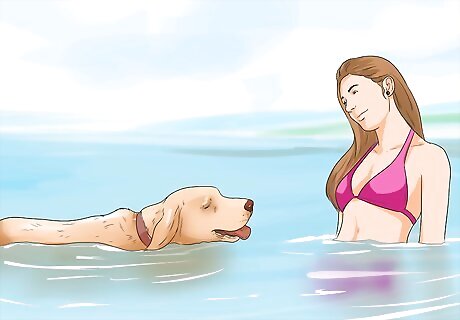
Swim with your dog. If you want to exercise your dog in another way, you can swim your dog. Swimming is excellent exercise for you stiff dog because the physical activity conditions his muscles and gets the joints moving. It is different from walking, however, because the joints don't have to take the dog's weight. Make sure you work with your dog because there is more to hydrotherapy than just putting your dog in the nearest swimming pool. Not all dogs are great swimmers and he may panic and drown. It is also not terribly hygienic. If you can, attend a special canine hydrotherapy unit that is staffed by a vet tech or a veterinary physiotherapist. These pools usually have a harness so your dog is supported in the water and is at no risk of drowning. The water temperature is carefully controlled so it is pleasant for the dog. Plus, the water is disinfected. The most sophisticated pools use water jets that brush against your dog's legs to stimulate paddling movements.

Work on weight control. If your dog's joint problems are due to weight, your vet will suggest that he lose weight. Helping your dog lose weight helps with mobility of arthritic and problem joints. An overweight dog has to carry more weight, which places additional strain on sore legs. For some dogs in the early stages of arthritis, going on a diet and getting down to a normal, healthy weight makes the difference between needing to start on medication or not. If you notice that your dog likes to overeat, don't leave out kibble for him to eat all day. You can also limit the amount of food he eats per day, especially if he eats multiple meals of canned food. You can also buy canned and dry food specifically developed to help your dog lose weight. Exercising your dog more will help make him lose weight. If his joints hurt too much, slowly increase the amount you walk him every day. Each little bit will help him gain strength and shed pounds. Talk to your vet about other a safe and effective way to shed those unwanted pounds.
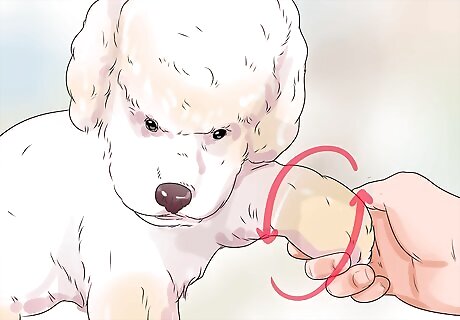
Try physiotherapy. Talk to your vet about physiotherapy treatments for your dog. If your dog is arthritic or has joint problems, he will need to warm up his joints before he starts working. Those stiff joints may even suffer further damage if he doesn't warm up before going for a walk. Try to get into the habit of doing your vet recommended passive physiotherapy with your dog at home before embarking on the walk. Vets typically will recommend passive physiotherapy, which includes certain kinds of activities. Encourage the dog to lie on his side. Gently rub all the muscles of both uppermost limbs, working one leg at a time. Then push on his paw and gently compress the leg so that all the joints bend up but only far enough that you don't cause pain. Next, gently pull on the paw to extend the leg. Repeat this 10-20 times for each leg. Have the dog roll over and do the same on the opposite side. Then he can go for his morning walk.

Warm him at night. There are environmental changes you can make to help with your dog's joint pain and stiffness. Many older, arthritic dogs stiffen up overnight because their muscles and joint go cold. The joints can rebel against the cold start and the dog is initially stiff. To reduce this, keep the pet warm overnight. Try strategies such as giving him a heated bed or a bed he can snuggle up in and keeps his joints warm. If he'll let you, cover him with a blanket at night and make sure he's not in any drafts. Try to raise his bed off the floor slightly.
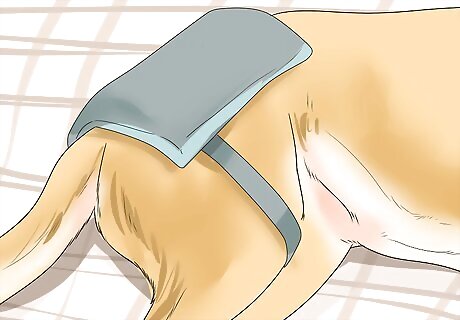
Use heat packs. If your dog has one or two troublesome joints, consider using heat packs. Get a microwaveable heat pack and apply the warm pack to the affected joint. Be careful not to burn the dog. If the pack seems too hot, wrap it in a towel before laying it on the joint. To assess the heat pack to see if it's safe for the dog, hold it against your own skin for a minute or two. It should be pleasantly warm rather than uncomfortably hot. If you have the urge to remove the pack ahead of two minutes because it feels hot, then the pack is too warm. Add an extra layer of insulation by wrapping it in a towel. If your dog is in too much pain or squirming around a lot, talk calmly to your dog to reassure him. The heat will eventually do its work and make him feel better.

Try massage therapy. Massage has a very beneficial effect by increasing the blood supply to muscles as well as conditioning and strengthening them. Muscles support the joints, so helping the muscles will help the joints. You should have a consultation with a qualified veterinary physiotherapist who can work out a massage regime designed for you individual dog. She will demonstrate how to give the massage so you are confident enough to do it at home. Always seek professional advice before starting massage. It could be possible to do more harm than good if you manipulated a limb in an inappropriate manner.

Give over the counter supplements. There are some over the counter joint supplements that you may want to give to your dog to help with joint pain. Ask your vet about glucosamine, an amino sugar that is the starting point for the production of new cartilage and is fundamental to maintaining joint function. You can also give him chondroitin, a major component of cartilage that maintains the spongy texture. This is essential to absorb shock as well as nourish and lubricate the joints. Glucosamine and chondroitin have a synergistic effect. This means that giving both together in the same supplement has a greater effect than you would expect. Look for a supplement that contains both glucosamine and chondroitin. Add cod liver oil to his food to help with the stiffness. However, CLO absorbs fat soluble vitamins, so giving it daily robs the dog of valuable nutrition. It is best to give CLO every other day so that his general health doesn't suffer. You can also give your dog omega-3 fatty acids, which are known to help with the inflammation of arthritis. Always consult your vet before giving your dog any supplements.

Consider medication. If your dog's situation is not improving with diet, exercise, and other methods, talk to your vet about medication. It is not the first choice for treatment, but it can be helpful if your dog is still in pain after trying other methods. Medication relieves pain and also reduces inflammation, which can decrease the chance of further damage. The drugs most widely prescribed are non-steroidal anti-inflammatory, known as NSAIDs. These drugs do not contain steroids, reduce inflammation, and inhibit pathways that cause pain. They have been through extensive safety trials and are safe for your dogs. NSAIDs are relatively safe drugs, especially when the correct dose is given with food in your dog's stomach. Your veterinarian may also want to check your dog's kidney function prior to starting treatment. Many medications are excreted through the kidney, which means they may build up in the blood stream if the kidneys aren't working properly. The main side effect is gastric ulceration, the first sign of which is vomiting. If your dog is prescribed a NSAID and he starts vomiting, stop the medication and contact your vet for advice. Always consult your vet before giving your dog any medications that are not specifically prescribed.

















Comments
0 comment